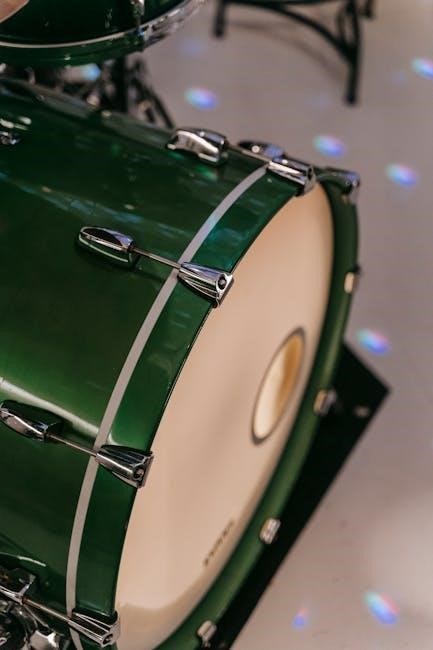Percussion Rudiments PDF: A Comprehensive Guide
Embark on a comprehensive journey into the world of percussion with our guide to rudiments‚ conveniently available in PDF format. This resource serves as a foundational tool‚ meticulously designed for drummers and percussionists of all skill levels‚ fostering skill enhancement.
Percussion rudiments represent the cornerstone of drumming and percussive arts‚ serving as the fundamental building blocks for rhythmic expression. These standardized patterns‚ encompassing rolls‚ flams‚ drags‚ and paradiddles‚ provide a structured approach to developing essential techniques. Mastering these rudiments equips percussionists with the dexterity‚ control‚ and coordination necessary to navigate diverse musical styles.
This introduction delves into the significance of percussion rudiments‚ highlighting their role in cultivating a strong rhythmic foundation. Whether you are a novice drummer embarking on your musical journey or an experienced percussionist seeking to refine your skills‚ understanding and practicing rudiments are paramount. They serve as the bedrock upon which complex rhythms and intricate drum fills are constructed.
We will explore the core concepts behind each rudiment‚ providing clear explanations and practical exercises to facilitate effective learning. By dedicating time to mastering these fundamental patterns‚ you will unlock a world of rhythmic possibilities.

The Importance of Rudiments in Percussion
Rudiments are essential for percussionists. They build technique‚ coordination‚ and control. Mastering them unlocks musicality‚ creativity‚ and versatility across styles. Rudiments form a strong foundation for drumming excellence.
Developing Fundamental Skills
Percussion rudiments are the cornerstone of developing fundamental skills for any aspiring drummer or percussionist. These standardized patterns serve as building blocks‚ enabling musicians to cultivate essential techniques such as stick control‚ hand-eye coordination‚ and rhythmic precision. By diligently practicing rudiments‚ players establish a solid foundation upon which more complex musical ideas can be built.
Rudiments provide a structured approach to mastering basic strokes‚ bounces‚ and flams‚ ensuring consistent execution and control. Through repetitive practice‚ muscle memory develops‚ allowing for fluid and effortless performance. Furthermore‚ rudiments enhance a player’s ability to maintain a steady tempo and execute dynamic variations with accuracy.
The systematic nature of rudimental practice promotes a deep understanding of rhythmic subdivisions and note values‚ fostering a strong sense of timing and groove. By mastering these core skills‚ percussionists gain the confidence and dexterity necessary to tackle diverse musical challenges with ease and proficiency. They are the basic for success.
Enhancing Musicality and Creativity
While percussion rudiments are essential for technical proficiency‚ their true value lies in their ability to unlock musicality and creativity. By mastering the fundamentals‚ drummers and percussionists gain the freedom to express themselves with greater nuance and imagination. Rudiments provide a vocabulary of rhythmic patterns that can be manipulated‚ combined‚ and adapted to create unique and compelling musical phrases.
Understanding rudiments allows players to break free from rigid patterns and explore the endless possibilities of rhythmic variation. By experimenting with different tempos‚ dynamics‚ and orchestrations‚ musicians can transform simple rudiments into intricate and expressive musical passages. Moreover‚ rudiments serve as a springboard for improvisation‚ enabling drummers to spontaneously generate new ideas and respond to the musical context in real-time.
The mastery of rudiments empowers percussionists to move beyond mere technical execution and infuse their playing with emotion‚ personality‚ and artistry. They become tools for musical expression‚ allowing drummers to communicate their unique voice and vision through the language of rhythm‚ making music fun and engaging.

The 40 International Drum Rudiments
The Percussive Arts Society (PAS) has defined 40 international drum rudiments. These encompass traditional‚ drum corps‚ orchestral‚ and contemporary styles. Mastering these rudiments offers a comprehensive foundation for any percussionist‚ broadening skills.
Roll Rudiments
Roll rudiments form a cornerstone of percussive technique‚ essential for developing control and fluidity. These rudiments primarily focus on sustained sounds and rhythmic continuity‚ achieved through various stick strokes and rebound techniques. Within the 40 international drum rudiments‚ roll rudiments are categorized into single-stroke‚ multiple-bounce‚ and double-stroke variations.
Single stroke roll rudiments‚ like the single stroke roll‚ single stroke four‚ and single stroke seven‚ emphasize consistent‚ even strokes. Multiple bounce roll rudiments‚ such as the multiple bounce roll and triple stroke roll‚ utilize the natural rebound of the stick for a smoother sound.
Double stroke open roll rudiments‚ including the five‚ six‚ seven‚ nine‚ ten‚ eleven‚ thirteen‚ fifteen‚ and seventeen stroke rolls‚ involve controlled double strokes followed by single strokes. Practicing these rudiments at varying tempos‚ from slow to fast and back‚ is crucial for building dexterity‚ precision‚ and dynamic control. This systematic approach will solidify fundamental skills‚ laying groundwork for more complex rhythmic patterns. Incorporating these exercises regularly enhances overall playing proficiency;
Flam Rudiments
Flam rudiments introduce a unique rhythmic texture through the combination of grace notes and primary notes played almost simultaneously. This creates a distinctive “flam” sound‚ adding depth and complexity to drumming patterns. The 40 international drum rudiments include a diverse array of flam-based exercises‚ each designed to refine timing and coordination.
Key flam rudiments include the flam‚ flam accent‚ flam tap‚ flamacue‚ flam paradiddle‚ single flammed mill‚ flam paradiddle-diddle‚ pataflafla‚ Swiss army triplet‚ inverted flam tap‚ and flam drag. These rudiments challenge drummers to control the precise placement of the grace note‚ creating the desired flam effect without blurring or rushing the primary beat.
Mastering flam rudiments requires focused practice on hand synchronization and rhythmic accuracy. Starting at slow tempos allows for meticulous attention to detail‚ gradually increasing speed as proficiency grows. Applying flam rudiments to drum set patterns and fills opens up a world of creative possibilities‚ enriching musical expression and expanding rhythmic vocabulary. Regular practice of these rudiments is essential for developing a solid rhythmic foundation.
Drag Rudiments
Drag rudiments are a fascinating category of percussion exercises characterized by the “drag‚” a double grace note preceding a primary note. This unique rhythmic figure adds a distinct flavor to drumming‚ enriching patterns and fills with syncopation and rhythmic interest. Understanding and mastering drag rudiments is essential for any aspiring drummer seeking to expand their technical and musical vocabulary.
The 40 international drum rudiments feature several key drag rudiments‚ including the drag‚ single drag tap‚ double drag tap‚ lesson 25‚ and single dragadiddle. Each of these rudiments presents a unique challenge in terms of timing‚ coordination‚ and rhythmic precision.
To effectively practice drag rudiments‚ start at a slow tempo and focus on achieving a clean‚ consistent drag sound. Pay close attention to the spacing between the grace notes and the primary note. As proficiency increases‚ gradually increase the tempo while maintaining accuracy. Experiment with applying drag rudiments to drum set patterns and fills‚ exploring the possibilities of incorporating this rhythmic element into musical expression.

How to Practice Rudiments Effectively
Effective rudiment practice involves focused repetition‚ tempo control‚ and dynamic variation. Start slowly‚ gradually increasing speed while maintaining precision. Apply rudiments to musical contexts‚ enhancing both technique and musicality. Consistent practice yields significant improvement.
Tempo Control and Dynamics
Mastering tempo control and dynamics is crucial for effective rudiment practice. Start by setting a metronome to a slow tempo‚ ensuring each note is clean and even. Gradually increase the tempo as your accuracy improves‚ pushing your limits without sacrificing precision; Remember to practice the rudiments from slow to fast and back to slow again.
Dynamics add depth and expression to your playing. Experiment with playing rudiments at different dynamic levels‚ from soft whispers to powerful accents. Focus on maintaining consistent stick height to achieve the desired volume‚ controlling the force of each stroke.
Incorporate accents strategically within the rudiments to highlight specific notes and create rhythmic interest. This enhances your ability to phrase and articulate musical ideas effectively. Practice varying dynamic patterns‚ such as crescendo and decrescendo‚ to add nuance and emotion to your drumming.
Tempo and dynamics work together to shape the musicality of your playing. By developing control over both‚ you can create captivating rhythms and captivating performances‚ elevating your overall drumming skills and musical expression.
Applying Rudiments to Drum Set Playing
Integrating rudiments into your drum set playing opens up a world of creative possibilities; Start by assigning different limbs to various parts of the kit‚ translating rudimental patterns into grooves and fills. For example‚ the single stroke roll can be played between the snare and hi-hat‚ creating a dynamic and energetic rhythm.
Experiment with orchestrating flam rudiments across the kit‚ using the snare and toms to emphasize the flam accents. This adds a unique flavor to your fills and grooves‚ creating interesting textures. The paradiddle can be adapted to create complex hi-hat patterns or fill ideas‚ incorporating bass drum accents for added depth.
Challenge yourself by applying drag rudiments to create intricate snare drum solos or embellishments within your beats. This adds a sophisticated and nuanced layer to your playing‚ showcasing your technical proficiency.
Remember to prioritize musicality over technical display‚ ensuring that the rudiments enhance the overall feel of the music. By creatively applying rudiments to the drum set‚ you can unlock new rhythmic ideas and develop your unique drumming voice‚ making your playing more expressive and captivating.

Resources for Learning Rudiments (PDFs and More)
To further your rudimental studies‚ a wealth of resources are readily available. Numerous websites and online platforms offer free PDFs containing comprehensive lists of the 40 International Drum Rudiments‚ often accompanied by detailed explanations and notation. The Percussive Arts Society (PAS) website is a prime example‚ providing authoritative information and resources on percussion education.
Beyond PDFs‚ explore online video tutorials that demonstrate proper technique and offer practice tips for each rudiment. Many experienced drummers and educators share their knowledge through platforms like YouTube‚ offering valuable insights and guidance.
Consider investing in instructional books dedicated to drum rudiments‚ which often include exercises‚ etudes‚ and practice routines to help you master each pattern. These books provide a structured approach to learning and can be a valuable asset to your practice regimen.
Don’t overlook the benefits of learning from a qualified drum teacher. A private instructor can provide personalized feedback‚ identify areas for improvement‚ and tailor lessons to your specific needs and goals; This individualized attention can significantly accelerate your progress and ensure you develop proper technique from the outset. Embrace the variety of resources available to you and embark on a fulfilling journey of rudimental mastery.
